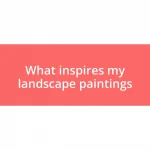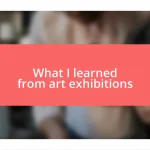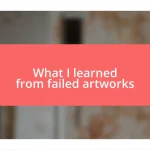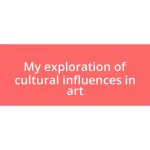Key takeaways:
- Art books provide a deep connection to artists and their experiences, combining visual inspiration with rich narratives that enhance understanding of art.
- Essential books for beginners, such as “Drawing on the Right Side of the Brain” and “The Story of Art,” are crucial for building foundational skills and appreciation for art history.
- Creating a personal art library encourages exploration and growth, allowing for diverse perspectives and the integration of old favorites with new discoveries to fuel creativity.

Introduction to Art Books
Art books hold a unique place in the world of creativity and expression. I remember the first time I opened a book filled with stunning reproductions of Van Gogh’s paintings; it was as if I was stepping into his world. The colors seemed to leap off the page, stirring something deep within me that made me yearn to understand more about the artist’s journey and techniques.
What is it about art books that ignites such passion? For me, it’s the combination of visual inspiration and rich narratives that often accompany each piece. Some of my most cherished volumes delve into the life stories behind artworks, sharing not just the “how” but also the “why.” Such insights connect me to artists across time and space, creating a bridge of understanding that makes the experience of viewing art profoundly personal.
There’s something comforting about flipping through the pages of a well-crafted art book. I often find myself lingering on certain pages, captivated by the details of brushstrokes or the intricate narratives behind individual pieces. In today’s fast-paced digital age, art books remind us of the beauty found in stillness and reflection—what’s not to love about that?

Essential Art Books for Beginners
When starting with art, a few foundational books can truly elevate your understanding and appreciation. One of my favorites is “Drawing on the Right Side of the Brain” by Betty Edwards. This book transforms the way beginners perceive and create art. I distinctly remember my first attempts at drawing; the exercises she guides you through helped liberate my creativity and broke down barriers I didn’t even know I had.
Another gem is “The Story of Art” by E.H. Gombrich. It’s incredibly approachable, weaving storytelling with art history beautifully. I recall being mesmerized by how Gombrich made complex concepts relatable and engaging. This book’s journey through visual arts from ancient to modern times ignited my curiosity to explore various artistic movements more deeply.
| Book Title | Author |
|—————————————|———————–|
| Drawing on the Right Side of the Brain | Betty Edwards |
| The Story of Art | E.H. Gombrich |
| Ways of Seeing | John Berger |
| Art 101 | Jennifer R. Dubose |

Must-Read Books on Techniques
When it comes to mastering techniques in art, a few standout books have profoundly impacted my creative journey. “Keys to Drawing” by Bert Dodson is one I often revisit. I still remember the first time I attempted one of Dodson’s drawings exercises—drawing with my non-dominant hand. That experience opened my eyes to new ways of perception, pushing me to explore beyond my comfort zone, ultimately transforming the way I approach every canvas.
Another essential volume is “The Artist’s Toolbox” by Alfred B. W. Smith. It’s intriguing how this book breaks down complex techniques into digestible steps that even a novice like me can follow. Each section feels like a friendly conversation, filled with insights that demystify the art-making process.
| Book Title | Author |
|————————–|———————–|
| Keys to Drawing | Bert Dodson |
| The Artist’s Toolbox | Alfred B. W. Smith |
| The New Drawing on the Right Side of the Brain | Betty Edwards |
| Color and Light | James Gurney |

Influential Modern Art Resources
Exploring modern art is like peeling back layers of a complex onion, and I found “Ways of Seeing” by John Berger to be exceptionally enlightening. This book challenges our perceptions by scrutinizing how we interpret visual art through various lenses—cultural, political, and economic. I remember sitting in a coffee shop, engrossed in Berger’s arguments about the male gaze in art, which prompted me to reconsider how societal views affect the artwork we admire. Isn’t it fascinating how a single book can shift your entire perspective on art?
When I stumbled upon “Art and Fear” by David Bayles and Ted Orland, it felt like a friend reassuring me through creative struggles. This resource dives deep into the psychological barriers many artists face, which resonated with my own experiences of self-doubt. I can recall a particularly tough time when I questioned my capabilities as an artist, and this book reminded me that these feelings are part of the journey. It encouraged me to embrace my fears as necessary steps toward growth.
Lastly, I can’t overlook “The Artist’s Way” by Julia Cameron. This book is more than just a guide; it’s a transformative experience. I started using the morning pages technique mentioned in it, which ignited my creativity and clarity each day. I often reflect on how this simple practice has become a vital part of my routine, not just in art but in life overall—showing me that we all need a little space to breathe and create. How do you cultivate creativity in your life?

Online Art Courses and Workshops
Online art courses and workshops have been invaluable in developing my artistic skills. I still remember my first online painting workshop; it felt surreal to be guided by a renowned artist from the comfort of my own home. The experience was both intimate and liberating—I could ask questions in real-time and connect with other participants who shared the same passion. Have you ever felt that rush of inspiration when you’re surrounded by like-minded creatives?
Platforms like Skillshare and Coursera offer a plethora of art courses, catering to every skill level. I’ve taken courses focusing on everything from watercolor techniques to digital illustration. What I appreciate most is how I can learn at my own pace, repeating sections until I feel confident. It reminds me of those late-night sessions when I’d pause a video to practice, sometimes losing track of time simply because I was so absorbed in the learning process.
Additionally, many workshops provide great opportunities for feedback, which I find crucial for growth. I recall attending a critique session where my piece was discussed; the feedback was both constructive and encouraging. It helped me see my work from new perspectives and made me realize that art is an evolving journey. How do you approach feedback in your creative pursuits? Embracing it can be transformative, turning anxiety into a powerful tool for improvement.
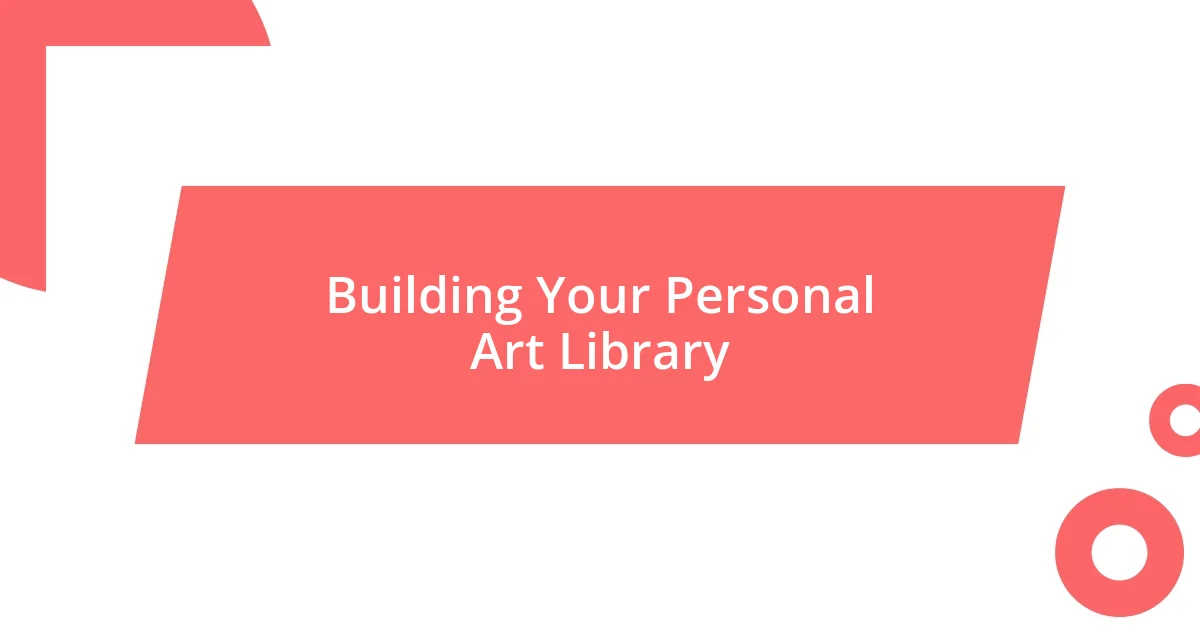
Building Your Personal Art Library
Building a personal art library is a deeply rewarding endeavor that extends beyond just collecting books—it’s about fostering an environment that fuels creativity. When I began curating my collection, I made a conscious effort to include diverse genres and perspectives. I remember walking into a small local bookstore and discovering a collection of art critiques; each page seemed to open a new dialogue in my mind, echoing the thoughts and emotions that I often struggled to articulate. How many times has a book inspired you to create something new or see the world differently?
I also discovered that some of my favorite resources came from unexpected places. A friend gifted me a beautifully illustrated book on the history of street art, which I initially thought wouldn’t resonate with me. But as I delved into it, I found myself captivated by the stories behind those vibrant murals—each one a reflection of community, struggle, and resilience. It prompted me to think about how the context of art can shape its meaning, and I couldn’t help but appreciate the connection these works had to broader social issues. Have you ever been surprised by how a book influenced your understanding of a particular art movement?
Lastly, I embraced the idea of rotating my selections. I often swap books on my shelf, pulling out an old favorite to revisit while introducing new titles that caught my eye. This keeps my space fresh and dynamic, allowing me to make unexpected connections between different artists and styles. I recall a moment when I paired a classic painting book with a contemporary artist’s monograph; it sparked a series of sketches that completely redefined my approach to color and form. I’ll ask you—does your art library inspire you to push boundaries, or is it simply a collection? Recognizing that it can be both a creative sanctuary and a source of innovative ideas might just transform how you view your collection.



